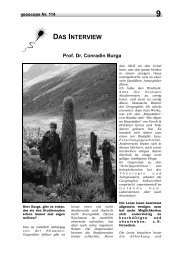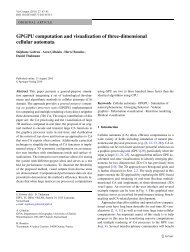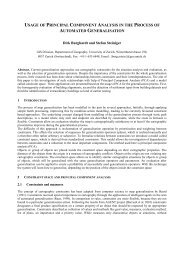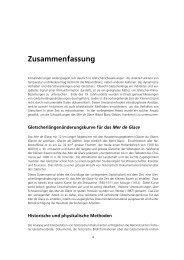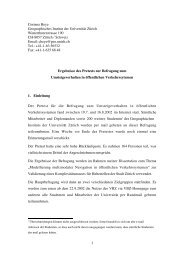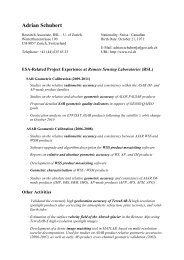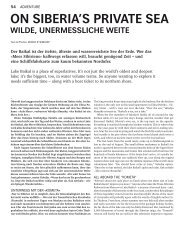19th century glacier representations and fluctuations in the central ...
19th century glacier representations and fluctuations in the central ...
19th century glacier representations and fluctuations in the central ...
You also want an ePaper? Increase the reach of your titles
YUMPU automatically turns print PDFs into web optimized ePapers that Google loves.
<strong>19th</strong> <strong>century</strong> <strong>glacier</strong> <strong>representations</strong> <strong>and</strong> <strong>fluctuations</strong> <strong>in</strong> <strong>the</strong> <strong>central</strong><br />
<strong>and</strong> western European Alps: An <strong>in</strong>terdiscipl<strong>in</strong>ary approach<br />
Abstract<br />
H.J. Zumbühl ⁎ , D. Ste<strong>in</strong>er ⁎ , S.U. Nussbaumer<br />
Institute of Geography, University of Bern, Hallerstrasse 12, CH-3012 Bern, Switzerl<strong>and</strong><br />
Received <strong>in</strong> revised form 22 August 2006; accepted 24 August 2006<br />
Available onl<strong>in</strong>e 22 February 2007<br />
European Alp<strong>in</strong>e <strong>glacier</strong>s are sensitive <strong>in</strong>dicators of past climate <strong>and</strong> are thus valuable sources of climate history. Unfortunately,<br />
direct determ<strong>in</strong>ations of <strong>glacier</strong> changes (length variations <strong>and</strong> mass changes) did not start with <strong>in</strong>creas<strong>in</strong>g accuracy until just before<br />
<strong>the</strong> end of <strong>the</strong> <strong>19th</strong> <strong>century</strong>. Therefore, historical <strong>and</strong> physical methods have to be used to reconstruct <strong>glacier</strong> variability for<br />
preceed<strong>in</strong>g time periods.<br />
The Lower Gr<strong>in</strong>delwald Glacier, Switzerl<strong>and</strong>, <strong>and</strong> <strong>the</strong> Mer de Glace, France, are examples of well-documented Alp<strong>in</strong>e <strong>glacier</strong>s<br />
with a wealth of different historical sources (e.g. draw<strong>in</strong>gs, pa<strong>in</strong>t<strong>in</strong>gs, pr<strong>in</strong>ts, photographs, maps) that allow reconstruction of<br />
<strong>glacier</strong> length variations for <strong>the</strong> last 400–500 years. In this paper, we compare <strong>the</strong> length <strong>fluctuations</strong> of both <strong>glacier</strong>s for <strong>the</strong> <strong>19th</strong><br />
<strong>century</strong> until <strong>the</strong> present.<br />
Dur<strong>in</strong>g <strong>the</strong> <strong>19th</strong> <strong>century</strong> a majority of Alp<strong>in</strong>e <strong>glacier</strong>s – <strong>in</strong>clud<strong>in</strong>g <strong>the</strong> Lower Gr<strong>in</strong>delwald Glacier <strong>and</strong> <strong>the</strong> Mer de Glace – have<br />
been affected by impressive <strong>glacier</strong> advances. The first maximum extent around 1820 has been documented by draw<strong>in</strong>gs from <strong>the</strong><br />
artist Samuel Birmann, <strong>and</strong> <strong>the</strong> second maximum extent around 1855 is shown by photographs of <strong>the</strong> Bisson Bro<strong>the</strong>rs. These<br />
pictorial sources are among <strong>the</strong> best documents of <strong>the</strong> two <strong>glacier</strong>s for <strong>the</strong> <strong>19th</strong> <strong>century</strong>.<br />
In addition to an analysis of historical sources of <strong>the</strong> <strong>19th</strong> <strong>century</strong>, we also study <strong>the</strong> sensitivity of <strong>the</strong> Lower Gr<strong>in</strong>delwald<br />
Glacier to climate parameters (multiproxy reconstructions of seasonal temperature <strong>and</strong> precipitation) for an advance <strong>and</strong> a retreat<br />
period <strong>in</strong> <strong>the</strong> <strong>19th</strong> <strong>century</strong> us<strong>in</strong>g a new neural network approach. The advance towards 1820 was presumably driven by low summer<br />
temperatures <strong>and</strong> high autumn precipitation. The 1860–1880 retreat period was ma<strong>in</strong>ly forced by high temperatures. F<strong>in</strong>ally, this<br />
nonl<strong>in</strong>ear statistical approach is a new contribution to <strong>the</strong> various <strong>in</strong>vestigations of <strong>the</strong> complex climate–<strong>glacier</strong> system.<br />
© 2007 Elsevier B.V. All rights reserved.<br />
Keywords: <strong>glacier</strong> <strong>fluctuations</strong>; historical sources; sensitivity analysis; neural network<br />
1. Introduction<br />
Available onl<strong>in</strong>e at www.sciencedirect.com<br />
Global <strong>and</strong> Planetary Change 60 (2008) 42–57<br />
Dur<strong>in</strong>g <strong>the</strong> <strong>19th</strong> <strong>century</strong> impressive <strong>glacier</strong> advances<br />
affected <strong>the</strong> majority of <strong>the</strong> Alp<strong>in</strong>e <strong>glacier</strong>s. This can be<br />
⁎ Correspond<strong>in</strong>g authors. Tel.: +41 31 631 85 51; fax: +41 31 631 85 11.<br />
E-mail addresses: zumbuehl@giub.unibe.ch (H.J. Zumbühl),<br />
ste<strong>in</strong>er@giub.unibe.ch (D. Ste<strong>in</strong>er).<br />
0921-8181/$ - see front matter © 2007 Elsevier B.V. All rights reserved.<br />
doi:10.1016/j.gloplacha.2006.08.005<br />
www.elsevier.com/locate/gloplacha<br />
deduced from natural archives <strong>and</strong> a wealth of<br />
documentary evidence (e.g. Zumbühl <strong>and</strong> Holzhauser,<br />
1988; Maisch et al., 1999). In general, historical records<br />
give a detailed picture of glacial <strong>fluctuations</strong> <strong>and</strong> allow<br />
study<strong>in</strong>g <strong>glacier</strong> history fur<strong>the</strong>r back <strong>in</strong> time than would<br />
be possible from direct measurements alone (e.g.<br />
Holzhauser et al., 2005). For <strong>in</strong>stance, empirical qualitative<br />
<strong>and</strong>/or quantitative data on <strong>the</strong> length, area <strong>and</strong><br />
volume of <strong>glacier</strong>s can be derived from <strong>the</strong>se sources.
This study focuses on two well-documented Alp<strong>in</strong>e<br />
<strong>glacier</strong>s, <strong>the</strong> Lower Gr<strong>in</strong>delwald Glacier, Switzerl<strong>and</strong>,<br />
<strong>and</strong> <strong>the</strong> Mer de Glace, France (Fig. 1). For both <strong>glacier</strong>s<br />
H.J. Zumbühl et al. / Global <strong>and</strong> Planetary Change 60 (2008) 42–57<br />
we present different k<strong>in</strong>ds of historical pictorial sources<br />
(draw<strong>in</strong>gs <strong>and</strong> photographs) that toge<strong>the</strong>r document <strong>the</strong><br />
<strong>19th</strong> <strong>century</strong> <strong>glacier</strong> maximum extents around 1820<br />
Fig. 1. Geographical location of study sites: (a) <strong>the</strong> Gr<strong>in</strong>delwald region with <strong>the</strong> Lower Gr<strong>in</strong>delwald Glacier, (b) <strong>the</strong> Mont Blanc region with <strong>the</strong> Mer<br />
de Glace.<br />
43
44 H.J. Zumbühl et al. / Global <strong>and</strong> Planetary Change 60 (2008) 42–57<br />
<strong>and</strong> 1855. Samuel Birmann (1793–1847), an important<br />
Swiss l<strong>and</strong>scape artist, portrayed <strong>the</strong> Lower Gr<strong>in</strong>delwald<br />
Glacier <strong>and</strong> <strong>the</strong> Mer de Glace at <strong>the</strong>ir first<br />
maximum extent around 1820 <strong>in</strong> detailed draw<strong>in</strong>gs of<br />
<strong>the</strong>ir <strong>glacier</strong> snouts. The Bisson Bro<strong>the</strong>rs, famous<br />
photographers of that time, made pictures of <strong>the</strong> two<br />
<strong>glacier</strong>s at <strong>the</strong>ir second maximum extent around 1855,<br />
aga<strong>in</strong> <strong>in</strong>clud<strong>in</strong>g detailed views of <strong>the</strong>ir <strong>glacier</strong> snouts.<br />
Therefore, <strong>the</strong> historical sources of <strong>the</strong> two <strong>glacier</strong>s<br />
allow comparison of <strong>the</strong>se extraord<strong>in</strong>ary high-quality<br />
<strong>glacier</strong> <strong>representations</strong> at <strong>the</strong>ir maximum extent. It<br />
must be noted that <strong>the</strong> change of <strong>glacier</strong> representation<br />
techniques from draw<strong>in</strong>gs to photographs demonstrates<br />
also <strong>the</strong> chang<strong>in</strong>g view on <strong>glacier</strong>s from <strong>the</strong> magic<br />
to <strong>the</strong> scientific (Haeberli <strong>and</strong> Zumbühl, 2003; Ste<strong>in</strong>er<br />
et al., <strong>in</strong> press).<br />
Fur<strong>the</strong>rmore, <strong>the</strong> <strong>19th</strong> <strong>century</strong> provides also an<br />
opportunity to analyze <strong>the</strong> climatic conditions of <strong>the</strong><br />
last widespread <strong>glacier</strong> advance <strong>and</strong> <strong>the</strong> follow<strong>in</strong>g<br />
retreat. This is done by connect<strong>in</strong>g new gridded<br />
reconstructions of temperature <strong>and</strong> precipitation (Luterbacher<br />
et al., 2004; Paul<strong>in</strong>g et al., 2006) with <strong>the</strong> data<br />
of length <strong>fluctuations</strong> of <strong>the</strong> Lower Gr<strong>in</strong>delwald<br />
Glacier. Because <strong>the</strong> climate–<strong>glacier</strong> relation is, <strong>in</strong><br />
part, nonl<strong>in</strong>ear (Ste<strong>in</strong>er et al., 2005), we suggest a new<br />
statistical nonl<strong>in</strong>ear approach based on a neural<br />
network to <strong>in</strong>vestigate <strong>the</strong> climate–<strong>glacier</strong> system, i.e.<br />
to study <strong>the</strong> meteorological conditions which led to a<br />
<strong>glacier</strong> advance or retreat. In a sensitivity analysis that<br />
explores <strong>the</strong> significance of climatic <strong>in</strong>puts to <strong>the</strong><br />
<strong>glacier</strong> system we evaluate <strong>the</strong> relevant climatic<br />
variables that caused <strong>the</strong> advance towards 1820 <strong>and</strong><br />
<strong>the</strong> rapid retreat of <strong>the</strong> Lower Gr<strong>in</strong>delwald Glacier after<br />
1860.<br />
In this paper, we compare <strong>the</strong> length <strong>fluctuations</strong> of<br />
<strong>the</strong> Lower Gr<strong>in</strong>delwald Glacier <strong>and</strong> <strong>the</strong> Mer de Glace<br />
s<strong>in</strong>ce 1800. S<strong>in</strong>ce this approach is descriptive, we also<br />
present a neural network model to explore potential<br />
climate forc<strong>in</strong>gs to expla<strong>in</strong> <strong>glacier</strong> length <strong>fluctuations</strong><br />
with <strong>the</strong> Lower Gr<strong>in</strong>delwald Glacier. Therefore,<br />
<strong>the</strong> analysis of historical sources provides a<br />
framework for which we can test <strong>the</strong> relative importance<br />
of climate variables forc<strong>in</strong>g <strong>glacier</strong> advance<br />
<strong>and</strong> retreat.<br />
2. Data <strong>and</strong> methods<br />
2.1. Study area<br />
Our study focuses on <strong>the</strong> Lower Gr<strong>in</strong>delwald<br />
Glacier, located <strong>in</strong> <strong>the</strong> nor<strong>the</strong>rn Bernese Alps (Switzerl<strong>and</strong>),<br />
<strong>and</strong> <strong>the</strong> Mer de Glace, located on <strong>the</strong> north face<br />
of <strong>the</strong> Mont Blanc (France). The topography <strong>and</strong> some<br />
l<strong>and</strong>mark locations of <strong>the</strong>se two <strong>glacier</strong>s are shown <strong>in</strong><br />
Fig. 1.<br />
The Lower Gr<strong>in</strong>delwald Glacier (46°35′ N, 8°05′ E)<br />
is a valley <strong>glacier</strong>, 8.85 km long <strong>and</strong> cover<strong>in</strong>g a surface<br />
of 20.6 km 2 . Ischmeer <strong>in</strong> <strong>the</strong> east <strong>and</strong> <strong>the</strong> Bernese<br />
Fiescher Glacier <strong>in</strong> <strong>the</strong> west jo<strong>in</strong> to form <strong>the</strong> tongue of<br />
<strong>the</strong> Lower Gr<strong>in</strong>delwald Glacier (Fig. 1a). The ma<strong>in</strong><br />
contribution of ice presently orig<strong>in</strong>ates from <strong>the</strong> Bernese<br />
Fiescher Glacier (Holzhauser <strong>and</strong> Zumbühl, 1996;<br />
Schmeits <strong>and</strong> Oerlemans, 1997). The approximated<br />
equilibrium l<strong>in</strong>e altitude (ELA), derived from digital<br />
elevation models (DEMs), is at 2640 m a.s.l. The <strong>glacier</strong><br />
today term<strong>in</strong>ates at 1297 m a.s.l. <strong>in</strong> a narrow gorge so<br />
that reliable observations are difficult to obta<strong>in</strong> (data<br />
from 2004: Ste<strong>in</strong>er et al., <strong>in</strong> press).<br />
The Mer de Glace (45°54′ N, 8°57′ E) sensu lato is a<br />
compound valley <strong>glacier</strong>, 12.0 km long <strong>and</strong> cover<strong>in</strong>g a<br />
surface of 31.9 km 2 (without <strong>in</strong>clud<strong>in</strong>g Glacier de<br />
Talèfre). The <strong>glacier</strong> is fed by several tributaries with <strong>the</strong><br />
Glacier du Géant be<strong>in</strong>g <strong>the</strong> most important one (Fig. 1b).<br />
S<strong>in</strong>ce <strong>the</strong> 1931–1969 retreat, <strong>the</strong> Glacier du Talèfre is<br />
separated from <strong>the</strong> ma<strong>in</strong> ice stream. The Mer de Glace<br />
sensu stricto refers to <strong>the</strong> lowest approximately 5 km<br />
of <strong>the</strong> ice stream, form<strong>in</strong>g <strong>the</strong> <strong>glacier</strong> tongue beneath<br />
Montenvers. The ELA is situated at around 2775 m a.s.l.,<br />
<strong>and</strong> <strong>the</strong> <strong>glacier</strong> today term<strong>in</strong>ates at 1467 m a.s.l. (data<br />
from 2001: Nussbaumer et al., <strong>in</strong> press).<br />
The Bernese Alps is a group of mounta<strong>in</strong> ranges <strong>in</strong><br />
<strong>the</strong> <strong>central</strong> part of <strong>the</strong> Alps dra<strong>in</strong>ed by <strong>the</strong> river Aare <strong>and</strong><br />
its tributary Saane <strong>in</strong> <strong>the</strong> north, <strong>and</strong> <strong>the</strong> Rhône <strong>in</strong> <strong>the</strong><br />
south <strong>and</strong> <strong>the</strong> Reuss <strong>in</strong> <strong>the</strong> east. The nor<strong>the</strong>rn part of <strong>the</strong><br />
Bernese Alps, <strong>in</strong>clud<strong>in</strong>g <strong>the</strong> Lower Gr<strong>in</strong>delwald Glacier,<br />
is exposed to <strong>the</strong> westerlies <strong>and</strong> receives maximum<br />
precipitation dur<strong>in</strong>g summer, with low variability. The<br />
mean annual temperature at Gr<strong>in</strong>delwald (1040 m a.s.l.),<br />
located approximately 3 km from <strong>the</strong> <strong>glacier</strong> front of <strong>the</strong><br />
Lower Gr<strong>in</strong>delwald Glacier, was 6.7 °C dur<strong>in</strong>g <strong>the</strong><br />
1966–1989 period. The mean temperature dur<strong>in</strong>g <strong>the</strong><br />
accumulation season (October–April) <strong>and</strong> ablation<br />
season (May–September) dur<strong>in</strong>g <strong>the</strong> 1966–1989 period<br />
was 2.3 °C <strong>and</strong> 12.9 °C, respectively.<br />
The mean annual precipitation dur<strong>in</strong>g <strong>the</strong> 1961–1990<br />
period was 1428 mm with precipitation dur<strong>in</strong>g <strong>the</strong><br />
accumulation season (October–April) <strong>and</strong> ablation<br />
season (May–September) of 720 mm <strong>and</strong> 708 mm,<br />
respectively (data from <strong>the</strong> onl<strong>in</strong>e database of Meteo-<br />
Swiss). Because of high precipitation (locally exceed<strong>in</strong>g<br />
4000 mm per year), <strong>the</strong> Bernese Alps have a relative low<br />
<strong>glacier</strong> equilibrium l<strong>in</strong>e altitude <strong>and</strong> is <strong>the</strong> heaviest<br />
<strong>glacier</strong>ized region <strong>in</strong> <strong>the</strong> Alps. Both <strong>the</strong> <strong>glacier</strong> with <strong>the</strong><br />
lowest front (Lower Gr<strong>in</strong>delwald Glacier) <strong>and</strong> <strong>the</strong>
largest <strong>glacier</strong> of <strong>the</strong> Alps (Great Aletsch Glacier) are<br />
located with<strong>in</strong> this region (Kirchhofer <strong>and</strong> Sevruk,<br />
1992; Imhof, 1998).<br />
Due to <strong>the</strong> extraord<strong>in</strong>ary low position of <strong>the</strong> term<strong>in</strong>us<br />
<strong>and</strong> its easy accessibility, <strong>the</strong> Lower Gr<strong>in</strong>delwald<br />
Glacier is one of <strong>the</strong> best-documented <strong>glacier</strong>s <strong>in</strong> <strong>the</strong><br />
Swiss Alps, <strong>and</strong> likely <strong>in</strong> <strong>the</strong> world. The cumulative<br />
length <strong>fluctuations</strong> of <strong>the</strong> Lower Gr<strong>in</strong>delwald Glacier,<br />
derived from documentary evidence, covers <strong>the</strong> period<br />
1535–1983 <strong>in</strong>clud<strong>in</strong>g <strong>the</strong> two well-known <strong>glacier</strong><br />
maxima about 1600 <strong>and</strong> 1855/56 (Zumbühl, 1980;<br />
Holzhauser <strong>and</strong> Zumbühl, 1996, 2003).<br />
The Mont Blanc mounta<strong>in</strong> range (Fig. 1) extends<br />
50 km from Martigny (Switzerl<strong>and</strong>) <strong>in</strong> <strong>the</strong> nor<strong>the</strong>ast to<br />
St. Gervais (France) <strong>in</strong> <strong>the</strong> southwest, form<strong>in</strong>g <strong>the</strong><br />
watershed between France <strong>and</strong> Italy <strong>and</strong> separat<strong>in</strong>g <strong>the</strong><br />
uppermost catchment areas of <strong>the</strong> Rhône <strong>and</strong> Po rivers.<br />
On <strong>the</strong> French side of <strong>the</strong> mounta<strong>in</strong> range, <strong>the</strong> upper<br />
Arve river flows down <strong>the</strong> deep trough of Chamonix,<br />
with several <strong>glacier</strong>s (Glacier du Tour, Glacier d'Argentière,<br />
Mer de Glace, Glacier des Bossons) dra<strong>in</strong><strong>in</strong>g<br />
<strong>in</strong>to this river. Climate <strong>in</strong> <strong>the</strong> valley of Chamonix is<br />
typical for <strong>the</strong> western Alps <strong>and</strong> comparable to <strong>the</strong><br />
Gr<strong>in</strong>delwald area, although slightly drier. Annual<br />
temperature of <strong>the</strong> Chamonix meteorological station<br />
(1054 m a.s.l.) is 6.6 °C for <strong>the</strong> 1935–1960 period,<br />
<strong>the</strong> annual precipitation amounts to 1262 mm for <strong>the</strong><br />
1934–1962 period (Wetter, 1987).<br />
The Mer de Glace is <strong>the</strong> longest <strong>and</strong> largest <strong>glacier</strong><br />
of <strong>the</strong> western Alps. Dur<strong>in</strong>g <strong>the</strong> Little Ice Age (LIA),<br />
<strong>the</strong> period last<strong>in</strong>g a few centuries between <strong>the</strong> Middle<br />
Ages <strong>and</strong> <strong>the</strong> warm<strong>in</strong>g of <strong>the</strong> first half of <strong>the</strong> 20th<br />
<strong>century</strong> (Grove, 2004), <strong>the</strong> <strong>glacier</strong> nearly cont<strong>in</strong>uously<br />
reached <strong>the</strong> bottom of <strong>the</strong> valley of Chamonix at<br />
1000 m a.s.l. This lowest part of Mer de Glace was<br />
called Glacier des Bois which today has completely<br />
melted away. Similar to <strong>the</strong> Lower Gr<strong>in</strong>delwald Glacier,<br />
<strong>the</strong> Mer de Glace has been well observed by scientists,<br />
artists, <strong>and</strong> travellers s<strong>in</strong>ce <strong>the</strong> beg<strong>in</strong>n<strong>in</strong>g of alp<strong>in</strong>ism,<br />
lead<strong>in</strong>g to a large number of historical documentary<br />
data.<br />
2.2. Historical sources <strong>in</strong> glaciology<br />
If sufficient <strong>in</strong> quality <strong>and</strong> quantity, written documents<br />
<strong>and</strong> pictorial historical records (pa<strong>in</strong>t<strong>in</strong>gs,<br />
sketches, engrav<strong>in</strong>gs, photographs, chronicles, topographic<br />
maps, reliefs) provide a detailed picture of<br />
<strong>glacier</strong> <strong>fluctuations</strong> over <strong>the</strong> last few centuries. Us<strong>in</strong>g<br />
<strong>the</strong>se data, we can achieve a resolution of decades or, <strong>in</strong><br />
some cases, even <strong>in</strong>dividual years of ice marg<strong>in</strong><br />
positions (Zumbühl <strong>and</strong> Holzhauser, 1988; Holzhauser<br />
H.J. Zumbühl et al. / Global <strong>and</strong> Planetary Change 60 (2008) 42–57<br />
et al., 2005). The density of historical material prior to<br />
1800 highly depends on <strong>the</strong> elevation of <strong>the</strong> tongue <strong>and</strong><br />
<strong>the</strong> relationship between settlements <strong>and</strong> cultivated l<strong>and</strong><br />
<strong>and</strong> <strong>the</strong> <strong>glacier</strong> advances.<br />
Historical data have to be considered carefully <strong>and</strong><br />
local circumstances need to be taken <strong>in</strong>to account. The<br />
evaluation of historical sources, <strong>the</strong> so-called historical<br />
method, has to fulfill some conditions <strong>in</strong> order to<br />
obta<strong>in</strong> reliable results concern<strong>in</strong>g former <strong>glacier</strong><br />
extents (Zumbühl <strong>and</strong> Holzhauser, 1988): Firstly, <strong>the</strong><br />
dat<strong>in</strong>g of <strong>the</strong> document has to be known or reconstructed.<br />
This often <strong>in</strong>cludes labour-<strong>in</strong>tensive archive<br />
work. Secondly, <strong>the</strong> <strong>glacier</strong> <strong>and</strong> its surround<strong>in</strong>gs have<br />
to be represented realistically <strong>and</strong> topographically<br />
correct which requires certa<strong>in</strong> skills of <strong>the</strong> correspond<strong>in</strong>g<br />
artist. In addition, <strong>the</strong> artist's topographic position<br />
should be known; prom<strong>in</strong>ent features <strong>in</strong> <strong>the</strong> <strong>glacier</strong>'s<br />
surround<strong>in</strong>gs such as rock steps, hills or mounta<strong>in</strong><br />
peaks facilitate <strong>the</strong> evaluation of historical documentary<br />
data.<br />
Note that for both <strong>the</strong> Lower Gr<strong>in</strong>delwald Glacier,<br />
<strong>and</strong> <strong>the</strong> Mer de Glace, <strong>the</strong>re is a wealth of historical<br />
(pictorial) documents which has been evaluated.<br />
Probably <strong>the</strong> best example of a <strong>glacier</strong> curve derived<br />
from historical sources is <strong>the</strong> series of cumulative length<br />
changes of <strong>the</strong> Lower Gr<strong>in</strong>delwald Glacier (Zumbühl,<br />
1980; Zumbühl et al., 1983).<br />
2.3. Sensitivity analysis by neural networks<br />
The evaluation of historical data gives <strong>in</strong>sight <strong>in</strong>to<br />
<strong>the</strong> change <strong>in</strong> <strong>glacier</strong> length over time without show<strong>in</strong>g<br />
<strong>the</strong> climatic driv<strong>in</strong>g factors which presumably affected<br />
<strong>the</strong>se <strong>glacier</strong> changes. To <strong>in</strong>vestigate <strong>the</strong> relationship<br />
between <strong>the</strong> meteorological conditions <strong>and</strong> variations<br />
of <strong>glacier</strong>s many studies have been carried out. For<br />
<strong>in</strong>stance, regression techniques with different numbers<br />
<strong>and</strong> types of predictors have often been used (Oerlemans<br />
<strong>and</strong> Reichert, 2000, <strong>and</strong> references <strong>the</strong>re<strong>in</strong>).<br />
Besides <strong>the</strong>se classical methods that commonly use<br />
l<strong>in</strong>ear assumptions, neural network models (NNMs)<br />
have become popular for perform<strong>in</strong>g nonl<strong>in</strong>ear regression<br />
<strong>and</strong> classification (Ste<strong>in</strong>er et al., 2005, <strong>and</strong><br />
references <strong>the</strong>re<strong>in</strong>). Because <strong>glacier</strong> length is a<br />
complex function dependent on climate, time, <strong>glacier</strong><br />
geometry <strong>and</strong> o<strong>the</strong>r factors, it may be well-suited to<br />
nonl<strong>in</strong>ear model approaches. Therefore, modell<strong>in</strong>g results<br />
can complement <strong>the</strong> historical analysis <strong>in</strong> order<br />
to give a better picture of how, <strong>and</strong> why <strong>the</strong> <strong>glacier</strong> has<br />
reacted.<br />
Inspired by <strong>the</strong> human bra<strong>in</strong>, a neural network (NN)<br />
consists of a set of highly <strong>in</strong>terconnected units, which<br />
45
46 H.J. Zumbühl et al. / Global <strong>and</strong> Planetary Change 60 (2008) 42–57<br />
process <strong>in</strong>formation as a response to external stimuli. A<br />
neural network is thus a simplistic ma<strong>the</strong>matical<br />
representation of <strong>the</strong> bra<strong>in</strong> that emulates <strong>the</strong> signal<br />
<strong>in</strong>tegration <strong>and</strong> threshold fir<strong>in</strong>g behaviour of biological<br />
neurons by means of ma<strong>the</strong>matical equations.<br />
The most widely used NN models are <strong>the</strong> feedforward<br />
neural networks (Rumelhart et al., 1986).<br />
Their applications cover a broad field of <strong>the</strong> environmental<br />
sciences <strong>in</strong>clud<strong>in</strong>g meteorology <strong>and</strong> climatology.<br />
Some examples of recent applications us<strong>in</strong>g<br />
NN <strong>in</strong>clude <strong>the</strong> detection of anthropogenic climate<br />
change (Walter <strong>and</strong> Schönwiese, 2002, 2003) <strong>and</strong> <strong>the</strong><br />
study of an Alp<strong>in</strong>e <strong>glacier</strong> mass balance (Ste<strong>in</strong>er et al.,<br />
2005).<br />
In this study <strong>the</strong> st<strong>and</strong>ard NN model, <strong>the</strong> Backpropagation<br />
Network (BPN), was applied (Rumelhart<br />
et al., 1986). This network architecture is based on a<br />
supervised learn<strong>in</strong>g algorithm to f<strong>in</strong>d a m<strong>in</strong>imum cost<br />
function. Because this approach bears a certa<strong>in</strong> risk of<br />
overfitt<strong>in</strong>g, <strong>the</strong> data have to be separated <strong>in</strong>to a tra<strong>in</strong><strong>in</strong>g<br />
<strong>and</strong> a validation subset. The actual ‘learn<strong>in</strong>g’ process<br />
of <strong>the</strong> network is performed on <strong>the</strong> tra<strong>in</strong><strong>in</strong>g subset<br />
only, whereas <strong>the</strong> validation subset serves as an<br />
<strong>in</strong>dependent reference for <strong>the</strong> simulation quality. This<br />
technique is called Cross-Validation (Stone, 1974;<br />
Michaelsen, 1987). When apply<strong>in</strong>g NN models to a<br />
nonstationary time series, as <strong>in</strong> this approach, <strong>the</strong><br />
tra<strong>in</strong><strong>in</strong>g subset <strong>in</strong>cludes <strong>the</strong> full range of extremes <strong>in</strong><br />
both predictors <strong>and</strong> predict<strong>and</strong>s. O<strong>the</strong>rwise, <strong>the</strong> algorithm<br />
will fail dur<strong>in</strong>g <strong>the</strong> validation process if confronted<br />
with an extreme value that was not part of <strong>the</strong><br />
tra<strong>in</strong><strong>in</strong>g subset. We used 75% of all data for tra<strong>in</strong><strong>in</strong>g<br />
<strong>and</strong> <strong>the</strong> rema<strong>in</strong><strong>in</strong>g 25% for validation (Walter <strong>and</strong><br />
Schönwiese, 2003).<br />
A typical NN model consists of three layers: <strong>in</strong>put,<br />
process<strong>in</strong>g <strong>and</strong> output layers (Fig. 2). The <strong>in</strong>put to an<br />
NN model is a vector of elements xk, where <strong>the</strong> <strong>in</strong>dex k<br />
st<strong>and</strong>s for <strong>the</strong> number of <strong>in</strong>put units <strong>in</strong> <strong>the</strong> network. In<br />
this study two new gridded (0.5° ×0.5° resolution)<br />
multiproxy reconstructions of seasonal temperature<br />
(Luterbacher et al., 2004) <strong>and</strong> precipitation fields<br />
(Paul<strong>in</strong>g et al., 2006) from 1500–2000 for European<br />
l<strong>and</strong> areas were used as <strong>in</strong>put data. These <strong>in</strong>puts serve as<br />
climatic driv<strong>in</strong>g factors to <strong>the</strong> <strong>glacier</strong> system. Before<br />
processed <strong>the</strong> <strong>in</strong>puts are weighted with weights wjk<br />
where j represents <strong>the</strong> number of process<strong>in</strong>g units, to<br />
give <strong>the</strong> <strong>in</strong>puts to <strong>the</strong> process<strong>in</strong>g units.<br />
Us<strong>in</strong>g too few/many process<strong>in</strong>g units can lead to<br />
underfitt<strong>in</strong>g/overfitt<strong>in</strong>g problems because <strong>the</strong> simulation<br />
results are highly sensitive to <strong>the</strong> number of process<strong>in</strong>g<br />
units <strong>and</strong> learn<strong>in</strong>g parameters. Therefore a variety of<br />
BPNs must be checked to obta<strong>in</strong> robust results.<br />
For <strong>the</strong> simulation of <strong>the</strong> <strong>glacier</strong> length variations of<br />
<strong>the</strong> Lower Gr<strong>in</strong>delwald Glacier we used six potential<br />
<strong>in</strong>put units as forc<strong>in</strong>gs (Temp_MAM, Temp_JJA,<br />
Temp_SON, Prec_DJF, Prec_MAM, Prec_SON), each<br />
of <strong>the</strong>m have been stepwise shifted so that all lags<br />
between 0 <strong>and</strong> 45 years are considered to account for <strong>the</strong><br />
uncerta<strong>in</strong> <strong>and</strong> chang<strong>in</strong>g reaction time of this <strong>glacier</strong>. As<br />
target function we apply <strong>the</strong> curve of length variations of<br />
<strong>the</strong> Lower Gr<strong>in</strong>delwald Glacier. In this manner <strong>the</strong> NN<br />
model will use those shifted <strong>in</strong>put series that expla<strong>in</strong> <strong>the</strong><br />
<strong>glacier</strong> length variations. Hence, <strong>the</strong>re are 46·6=276<br />
<strong>in</strong>put units (climate variables), 138 process<strong>in</strong>g units <strong>in</strong> 1<br />
Fig. 2. An example of a simplified 3-layer k–j–1 BPN architecture. The concept of <strong>the</strong> backpropagation tra<strong>in</strong><strong>in</strong>g algorithm is shown by several arrows<br />
(from Ste<strong>in</strong>er et al., 2005). Note that <strong>in</strong> our study <strong>the</strong> <strong>in</strong>put layer consists of <strong>the</strong> climatic <strong>in</strong>puts <strong>and</strong> <strong>the</strong> output layer represents <strong>the</strong> <strong>glacier</strong> length.
process<strong>in</strong>g layer <strong>and</strong> <strong>the</strong> length <strong>fluctuations</strong> as output<br />
unit. This neural network architecture is abbreviated as<br />
276-138-1.<br />
After weight<strong>in</strong>g <strong>and</strong> add<strong>in</strong>g of <strong>the</strong> <strong>in</strong>puts, <strong>the</strong> results<br />
were passed to nonl<strong>in</strong>ear activation functions (e.g.<br />
sigmoid functions) <strong>in</strong> each process<strong>in</strong>g unit (process<strong>in</strong>g<br />
layer <strong>in</strong> Fig. 2). These functions produced <strong>the</strong> output of<br />
<strong>the</strong> process<strong>in</strong>g layer. The outputs of <strong>the</strong> process<strong>in</strong>g units<br />
are fed to <strong>the</strong> output layer where <strong>the</strong>y are aga<strong>in</strong> weighted<br />
with <strong>the</strong> weights W ij. The use of a second activation<br />
function will f<strong>in</strong>ally produce <strong>the</strong> output of <strong>the</strong> network<br />
(output layer <strong>in</strong> Fig. 2).<br />
The purpose of tra<strong>in</strong><strong>in</strong>g an NN model is to f<strong>in</strong>d a set<br />
of coefficients that reduces <strong>the</strong> error between <strong>the</strong> model<br />
outputs <strong>and</strong> <strong>the</strong> given test data y(xk). This is usually<br />
done by adjust<strong>in</strong>g <strong>the</strong> weights Wij <strong>and</strong> wjk to m<strong>in</strong>imize<br />
<strong>the</strong> least square error. One way to adjust <strong>the</strong>se weights<br />
is error backpropagation. The backpropagation tra<strong>in</strong><strong>in</strong>g<br />
consists of two passes of computation: a forward pass<br />
<strong>and</strong> a backward pass. In <strong>the</strong> forward pass an <strong>in</strong>put<br />
vector is applied to <strong>the</strong> units <strong>in</strong> <strong>the</strong> <strong>in</strong>put layer. The<br />
signals from <strong>the</strong> <strong>in</strong>put layer propagate to <strong>the</strong> units <strong>in</strong><br />
<strong>the</strong> process<strong>in</strong>g layer <strong>and</strong> each unit produces an output.<br />
The outputs of <strong>the</strong>se units are propagated to units <strong>in</strong><br />
subsequent layers. This process cont<strong>in</strong>ues until <strong>the</strong><br />
signals reach <strong>the</strong> output layer where <strong>the</strong> actual response<br />
of <strong>the</strong> network to <strong>the</strong> <strong>in</strong>put vector is obta<strong>in</strong>ed. Dur<strong>in</strong>g<br />
<strong>the</strong> forward pass <strong>the</strong> weights of <strong>the</strong> network are fixed.<br />
Dur<strong>in</strong>g <strong>the</strong> backward pass (see dashed arrows <strong>in</strong> Fig.<br />
2), on <strong>the</strong> o<strong>the</strong>r h<strong>and</strong>, <strong>the</strong> weights are all adjusted <strong>in</strong><br />
accordance with an error signal that is propagated<br />
backward through <strong>the</strong> network aga<strong>in</strong>st <strong>the</strong> <strong>in</strong>itial<br />
direction.<br />
As mentioned above, this network architecture still<br />
bears <strong>the</strong> risk of be<strong>in</strong>g stuck <strong>in</strong> local m<strong>in</strong>ima on <strong>the</strong> error<br />
hypersurface. To reduce this risk, conjugate gradient<br />
descent was used <strong>in</strong> this study. This is an improved<br />
version of st<strong>and</strong>ard backpropagation with accelerated<br />
convergence. A detailed description of this technique<br />
can be found <strong>in</strong> Ste<strong>in</strong>er et al. (2005).<br />
A second uncerta<strong>in</strong>ty <strong>in</strong> <strong>the</strong> BPN simulation is related<br />
to <strong>the</strong> fact that <strong>the</strong> identified m<strong>in</strong>imum is dependent on<br />
<strong>the</strong> start<strong>in</strong>g po<strong>in</strong>t on <strong>the</strong> error hypersurface. To reduce<br />
this k<strong>in</strong>d of uncerta<strong>in</strong>ty, <strong>the</strong> BPN was performed 30<br />
times, each time only vary<strong>in</strong>g <strong>the</strong> start<strong>in</strong>g po<strong>in</strong>t on <strong>the</strong><br />
error hypersurface. F<strong>in</strong>ally, <strong>the</strong> average of <strong>the</strong> 30 model<br />
results has been analyzed.<br />
Sensitivity analysis us<strong>in</strong>g neural networks is based<br />
on <strong>the</strong> measurements of <strong>the</strong> effect that is observed <strong>in</strong> <strong>the</strong><br />
output layer due to changes <strong>in</strong> <strong>the</strong> <strong>in</strong>put data. A common<br />
way to perform this analysis consists of compar<strong>in</strong>g <strong>the</strong><br />
error made by <strong>the</strong> network from <strong>the</strong> orig<strong>in</strong>al patterns<br />
H.J. Zumbühl et al. / Global <strong>and</strong> Planetary Change 60 (2008) 42–57<br />
with <strong>the</strong> error made when restrict<strong>in</strong>g <strong>the</strong> <strong>in</strong>put of <strong>in</strong>terest<br />
to <strong>the</strong> average value. Thus, <strong>the</strong> greater <strong>the</strong> <strong>in</strong>crease <strong>in</strong> <strong>the</strong><br />
error function upon restrict<strong>in</strong>g <strong>the</strong> <strong>in</strong>put, <strong>the</strong> greater <strong>the</strong><br />
importance of this <strong>in</strong>put <strong>in</strong> <strong>the</strong> output (e.g. Wang et al.,<br />
2000). In this study we kept one seasonal temperature or<br />
precipitation <strong>in</strong>put constant while <strong>the</strong> o<strong>the</strong>r <strong>in</strong>puts were<br />
allowed to fluctuate. The observed error of <strong>glacier</strong><br />
response gave us <strong>in</strong>dications of its sensitivity to <strong>the</strong><br />
<strong>in</strong>put that was constant.<br />
3. Results<br />
3.1. Two <strong>glacier</strong>s drawn by <strong>the</strong> artist Samuel<br />
Birmann — The first advance <strong>in</strong> <strong>the</strong> <strong>19th</strong> <strong>century</strong><br />
On <strong>the</strong> pencil watercolor draw<strong>in</strong>g by Samuel<br />
Birmann (1793–1847) made <strong>in</strong> September 1826 (Fig.<br />
3a), <strong>the</strong> marked fanshaped tongue – <strong>the</strong> “Schweif” or<br />
tail (cover<strong>in</strong>g <strong>the</strong> Schopfrocks) – of <strong>the</strong> Lower<br />
Gr<strong>in</strong>delwald Glacier extends far down <strong>in</strong>to <strong>the</strong> valley.<br />
The skyl<strong>in</strong>e of <strong>the</strong> draw<strong>in</strong>g is dom<strong>in</strong>ated by <strong>the</strong><br />
Mettenberg (left), <strong>the</strong> Fiescherhorn (center background)<br />
<strong>and</strong> <strong>the</strong> Hörnligrat (right; see Fig. 1). In <strong>the</strong> forefield of<br />
<strong>the</strong> <strong>glacier</strong> (right) we can clearly recognize a complex<br />
mora<strong>in</strong>e system. The wooden area between <strong>the</strong> ice front<br />
<strong>and</strong> <strong>the</strong> mora<strong>in</strong>e walls shows that <strong>the</strong> Lower Gr<strong>in</strong>delwald<br />
Glacier reached a bigger extension <strong>in</strong> earlier times<br />
(around 1600; Zumbühl, 1980), <strong>and</strong> that <strong>the</strong> 1814–<br />
1820/22 advance amounts to 450–520 m, approximately<br />
75–150 m beh<strong>in</strong>d <strong>the</strong> greatest LIA extension<br />
around 1600.<br />
In this context it must be noted that Samuel Birmann<br />
from Basel was “<strong>the</strong> most important Swiss romantic of<br />
topographic l<strong>and</strong>scape artists” (Zumbühl, 1997). We<br />
know of approximately 100 views of <strong>glacier</strong>s, all<br />
produced with<strong>in</strong> 20 years (1815–1835). The draw<strong>in</strong>gs<br />
are all of an outst<strong>and</strong><strong>in</strong>g topographic quality <strong>and</strong> due to<br />
<strong>the</strong> very wide angle often used <strong>in</strong> his views, <strong>the</strong>y are<br />
comparable to photographs, <strong>in</strong> many ways even superior<br />
to <strong>the</strong>m.<br />
Among this unique collection of <strong>glacier</strong> views by<br />
Samuel Birmann, <strong>the</strong>re is also a pencil watercolor<br />
draw<strong>in</strong>g of <strong>the</strong> Mer de Glace from 1823 (Fig. 3b). The<br />
draw<strong>in</strong>g shows <strong>the</strong> impressive peaks of <strong>the</strong> Aiguille<br />
Verte <strong>and</strong> les Drus (skyl<strong>in</strong>e) <strong>and</strong> <strong>the</strong> ice flow of <strong>the</strong><br />
Glacier des Bois that term<strong>in</strong>ated near <strong>the</strong> village of les<br />
Bois (roof <strong>and</strong> chimneys with smoke) <strong>in</strong> <strong>the</strong> valley<br />
bottom. Similar to Gr<strong>in</strong>delwald with <strong>the</strong> Schopfrocks<br />
<strong>the</strong> ice front term<strong>in</strong>ates <strong>in</strong> a rocky zone, Rochers des<br />
Mottets (middleground between village <strong>and</strong> peaks). A<br />
close look reveals also <strong>the</strong> mora<strong>in</strong>es of Côte du Piget<br />
(left).<br />
47
48 H.J. Zumbühl et al. / Global <strong>and</strong> Planetary Change 60 (2008) 42–57<br />
Fig. 3. The Swiss artist Samuel Birmann (1793–1847) portrayed (a) <strong>the</strong> Lower Gr<strong>in</strong>delwald Glacier <strong>in</strong> September 1826 (39.2 × 49.7 cm; pencil, pen,<br />
watercolor, bodycolor), (b) <strong>the</strong> Mer de Glace <strong>in</strong> August 1823 (44.3 × 58.9 cm; pencil, pen, watercolor, bodycolor). Kupferstichkab<strong>in</strong>ett,<br />
Kunstmuseum Basel. Photographs by He<strong>in</strong>z J. Zumbühl.<br />
In <strong>the</strong> “Souvenirs de la vallée de Chamonix”, a<br />
precious artbook with aquat<strong>in</strong>ts (colorpr<strong>in</strong>ts), Samuel<br />
Birmann writes to view No. 21 “Glacier des Bois”: “In<br />
1821, <strong>the</strong> <strong>glacier</strong> advanced until twenty feet to a house<br />
of <strong>the</strong> village [les Bois]; so <strong>the</strong> people prepared to leave<br />
<strong>the</strong>ir homes, but this time, <strong>the</strong> <strong>glacier</strong> respected his<br />
limits, <strong>and</strong> s<strong>in</strong>ce <strong>the</strong>n he started to melt back slowly”<br />
(translated from Birmann, 1826). The advance, start<strong>in</strong>g<br />
around 1800 <strong>and</strong> end<strong>in</strong>g <strong>in</strong> 1821, pushed <strong>the</strong> ice front <strong>in</strong><br />
<strong>the</strong> valley approximately 560 m (Nussbaumer et al., <strong>in</strong><br />
press). This amount is similar to Gr<strong>in</strong>delwald, but <strong>the</strong><br />
advance took place <strong>in</strong> a shorter time. In 1821, <strong>the</strong> Mer de<br />
Glace reached <strong>the</strong> largest extension <strong>in</strong> <strong>the</strong> <strong>19th</strong> <strong>century</strong>,<br />
comparable to <strong>the</strong> Rosenlaui Glacier <strong>in</strong> 1826 (Zumbühl<br />
<strong>and</strong> Holzhauser, 1988), but different to <strong>the</strong> Lower<br />
Gr<strong>in</strong>delwald Glacier which reached its peak <strong>in</strong> 1855/56.<br />
The same artist offers us also detailed views of <strong>the</strong><br />
fronts of <strong>the</strong> <strong>glacier</strong>s mentioned with two huge <strong>glacier</strong>
snouts <strong>in</strong> <strong>the</strong> valley bottom. Firstly, <strong>the</strong> Mer de Glace<br />
<strong>in</strong> 1823 with <strong>the</strong> source of <strong>the</strong> l'Arveyron is shown <strong>in</strong><br />
Fig. 4b, <strong>and</strong> secondly, <strong>the</strong> Lower Gr<strong>in</strong>delwald Glacier<br />
<strong>in</strong> 1826 with <strong>the</strong> source of <strong>the</strong> Lütsch<strong>in</strong>e is shown <strong>in</strong><br />
Fig. 4a.<br />
3.2. Two <strong>glacier</strong>s from <strong>the</strong> same photographer family<br />
(<strong>the</strong> Bisson Bro<strong>the</strong>rs) — The second mid <strong>19th</strong> <strong>century</strong><br />
advance<br />
The mid <strong>19th</strong> <strong>century</strong> was <strong>in</strong> many ways a very<br />
<strong>in</strong>terest<strong>in</strong>g time. Firstly, it brought <strong>the</strong> second advance<br />
<strong>and</strong> for many <strong>glacier</strong>s <strong>the</strong> maximum extension <strong>in</strong> <strong>the</strong><br />
<strong>19th</strong> <strong>century</strong>. Secondly, this time brought also a<br />
revolutionary change of <strong>glacier</strong> representation techni-<br />
H.J. Zumbühl et al. / Global <strong>and</strong> Planetary Change 60 (2008) 42–57<br />
ques, from draw<strong>in</strong>gs <strong>and</strong> pr<strong>in</strong>ts to <strong>the</strong> much more precise<br />
first photographs.<br />
The probably first photograph of <strong>the</strong> Lower<br />
Gr<strong>in</strong>delwald Glacier was taken by <strong>the</strong> Bisson Bro<strong>the</strong>rs<br />
(Fig. 5a). Louis Auguste Bisson “<strong>the</strong> older” (1814–<br />
1876), orig<strong>in</strong>ally architect, <strong>and</strong> his bro<strong>the</strong>r Auguste<br />
Rosalie Bisson, “<strong>the</strong> younger” (1826–1900), orig<strong>in</strong>ally<br />
pa<strong>in</strong>ter, founded <strong>in</strong> 1840 a company for produc<strong>in</strong>g<br />
daguerreotypes. Later, <strong>the</strong>y became very famous for<br />
<strong>the</strong>ir impressive photographic views of <strong>the</strong> Mont Blanc.<br />
These views were made for <strong>the</strong> French emperor<br />
Napoléon III.<br />
One of <strong>the</strong> big challenges us<strong>in</strong>g historical pictorial<br />
views <strong>in</strong> <strong>glacier</strong> reconstructions is <strong>the</strong> precise dat<strong>in</strong>g of<br />
<strong>the</strong> data sources, especially for photographs. Thanks to<br />
Fig. 4. Samuel Birmann also produced detailed views of <strong>the</strong> <strong>glacier</strong> snouts of (a) <strong>the</strong> Lower Gr<strong>in</strong>delwald Glacier <strong>in</strong> July 1826 (30.3 × 45.2 cm; pencil,<br />
pen, watercolor, bodycolor) <strong>and</strong> (b) <strong>the</strong> Mer de Glace <strong>in</strong> 1823 (30.1 × 45.7 cm; pencil, pen, watercolor, bodycolor). Kupferstichkab<strong>in</strong>ett,<br />
Kunstmuseum Basel. Photographs by He<strong>in</strong>z J. Zumbühl.<br />
49
50 H.J. Zumbühl et al. / Global <strong>and</strong> Planetary Change 60 (2008) 42–57<br />
Fig. 5. Photographs from <strong>the</strong> Bisson Bro<strong>the</strong>rs show<strong>in</strong>g (a) <strong>the</strong> Lower Gr<strong>in</strong>delwald Glacier <strong>in</strong> 1855/56 (34.2 × 44.4 cm) <strong>and</strong> (b) <strong>the</strong> Mer de Glace <strong>in</strong><br />
1854 (34.1 × 45.4 cm). Alp<strong>in</strong>e Club Library, London. Photographs by He<strong>in</strong>z J. Zumbühl.<br />
<strong>the</strong> grow<strong>in</strong>g <strong>in</strong>terest for this subject dur<strong>in</strong>g <strong>the</strong> last<br />
twenty years, we now have more possibilities to address<br />
this topic. For <strong>the</strong> probably oldest photograph of <strong>the</strong><br />
Lower Gr<strong>in</strong>delwald Glacier, <strong>the</strong>re are three proofs:<br />
Firstly, <strong>the</strong> black <strong>in</strong>k stamp “Bisson frères” at <strong>the</strong> edge of<br />
<strong>the</strong> photo (this black stamp was only used from 1854–<br />
1857; see Chlumsky et al., 1999), secondly, travels to<br />
Switzerl<strong>and</strong> <strong>in</strong> 1855/56 (Chlumsky et al., 1999), <strong>and</strong><br />
thirdly, an advertisement of <strong>the</strong> Bisson Bro<strong>the</strong>rs <strong>in</strong> <strong>the</strong><br />
journal “L’Artiste” (14 December 1856) give us strong<br />
evidence that <strong>the</strong> photograph was taken <strong>in</strong> 1855/56,<br />
dur<strong>in</strong>g <strong>the</strong> mid <strong>19th</strong> <strong>century</strong> maximum extension.<br />
Additionally, <strong>the</strong> photograph shows <strong>the</strong> <strong>glacier</strong> dur<strong>in</strong>g<br />
late summer/early autumn season as <strong>the</strong>re is a snow free<br />
ice front. Start<strong>in</strong>g from a high ice level just down <strong>in</strong> <strong>the</strong><br />
valley (a big part of <strong>the</strong> “Schweif” existed) <strong>the</strong> front of<br />
<strong>the</strong> Lower Gr<strong>in</strong>delwald Glacier advanced 75–150 m<br />
between 1839 (1843) <strong>and</strong> 1855/56 (Zumbühl, 1980).<br />
In 1849, John Rusk<strong>in</strong> made <strong>the</strong> oldest photo known<br />
from <strong>the</strong> Mer de Glace <strong>in</strong> <strong>the</strong> area of Montenvers. Five<br />
years later, <strong>in</strong> 1854, <strong>the</strong> Bisson Bro<strong>the</strong>rs took a photo of<br />
<strong>the</strong> Glacier des Bois <strong>in</strong> <strong>the</strong> valley bottom, maybe <strong>the</strong> first<br />
one from this site (de Decker Heftler, 2002; Fig. 5b).<br />
The frontal zone of <strong>the</strong> Mer de Glace advanced approximately<br />
290 m from 1842 to 1852 (Nussbaumer et al.,<br />
<strong>in</strong> press).<br />
Comparable to previous views we can now look at<br />
<strong>the</strong> impressive <strong>glacier</strong> snouts <strong>in</strong> <strong>the</strong> valley bottom <strong>in</strong>
detail. In 1861, a partially collapsed snout of <strong>the</strong> Lower<br />
Gr<strong>in</strong>delwald Glacier with <strong>the</strong> Lütsch<strong>in</strong>e (Fig. 6a) was<br />
photographed by Adolphe Braun (1812–1877; Kempf,<br />
H.J. Zumbühl et al. / Global <strong>and</strong> Planetary Change 60 (2008) 42–57<br />
1994). In 1859, <strong>the</strong> archlike snout of <strong>the</strong> Mer de Glace<br />
with <strong>the</strong> source of <strong>the</strong> Arveyron river was still <strong>in</strong>tact on<br />
<strong>the</strong> photo of <strong>the</strong> Bisson Bro<strong>the</strong>rs (Fig. 6b).<br />
Fig. 6. (a) The snout of <strong>the</strong> Lower Gr<strong>in</strong>delwald Glacier <strong>in</strong> 1861 (8.1 × 14.4 cm; cut-out). Stereograph “1109 Source de la Lutsch<strong>in</strong>e” by Adolphe<br />
Braun (1812–1877). Private Collection of Jaroslav F. Jebavy, Geneva. (b) The snout of <strong>the</strong> Mer de Glace <strong>in</strong> 1859 (23.2 × 39 cm). Photograph “Source<br />
de l’Arveyron” by <strong>the</strong> Bisson Bro<strong>the</strong>rs. Private collection of J. <strong>and</strong> S. Seydoux; Musée Savoisien, Chambéry (Exposition 2002).<br />
51
52 H.J. Zumbühl et al. / Global <strong>and</strong> Planetary Change 60 (2008) 42–57<br />
3.3. The history of <strong>the</strong> two <strong>glacier</strong>s from <strong>the</strong> <strong>19th</strong> <strong>century</strong><br />
until today — Variations of length based on historical<br />
pictorial <strong>and</strong> written sources/documents<br />
Historic length variation of <strong>the</strong> Lower Gr<strong>in</strong>delwald<br />
Glacier (Fig. 7) belongs to <strong>the</strong> world's best-documented<br />
<strong>and</strong> longest ones of its k<strong>in</strong>d thanks to a unique wealth of<br />
historic picture sources (Zumbühl, 1980; Zumbühl et al.,<br />
1983; Oerlemans, 2005). S<strong>in</strong>ce <strong>the</strong> 1980s we were able<br />
to collect new photographic documents which provide<br />
more detailed views of <strong>the</strong> mid <strong>19th</strong> <strong>century</strong> ice marg<strong>in</strong>s<br />
(Ste<strong>in</strong>er et al., <strong>in</strong> press).<br />
The cumulative length curve of <strong>the</strong> Mer de Glace<br />
(Fig. 7) is <strong>the</strong> result of <strong>the</strong> studies of Moug<strong>in</strong> (1912) <strong>and</strong><br />
Wetter (1987). Based on a huge collection of historical<br />
pictorial records, partly never studied before, Nussbaumer<br />
et al. (<strong>in</strong> press) ref<strong>in</strong>ed <strong>the</strong> curve of length variations<br />
of <strong>the</strong> Mer de Glace.<br />
Compar<strong>in</strong>g <strong>the</strong> cumulative length curves of <strong>the</strong> Lower<br />
Gr<strong>in</strong>delwald Glacier <strong>and</strong> <strong>the</strong> Mer de Glace for <strong>the</strong> <strong>19th</strong><br />
<strong>century</strong> yields <strong>the</strong> follow<strong>in</strong>g results (Fig. 7): Both<br />
<strong>glacier</strong>s show a rapid advance at <strong>the</strong> beg<strong>in</strong>n<strong>in</strong>g of <strong>the</strong><br />
<strong>19th</strong> <strong>century</strong>. The Lower Gr<strong>in</strong>delwald Glacier reaches its<br />
first maximum extent <strong>in</strong> 1820/22, <strong>the</strong> Mer de Glace <strong>in</strong><br />
1821. In <strong>the</strong> follow<strong>in</strong>g years both <strong>glacier</strong>s rema<strong>in</strong> <strong>in</strong> or<br />
near <strong>the</strong> valley bottom, imply<strong>in</strong>g no significant retreat.<br />
Then, <strong>in</strong> 1855/56 <strong>the</strong> Lower Gr<strong>in</strong>delwald Glacier<br />
reached its second peak of <strong>the</strong> <strong>19th</strong> <strong>century</strong> which was<br />
bigger than <strong>the</strong> 1820/22 extent, while <strong>the</strong> Mer de Glace<br />
had <strong>the</strong> second peak of <strong>the</strong> <strong>19th</strong> <strong>century</strong> <strong>in</strong> 1852/53<br />
which was less pronounced than <strong>in</strong> 1821.<br />
F<strong>in</strong>ally, after <strong>the</strong> end of <strong>the</strong> LIA both <strong>glacier</strong>s retreated<br />
dramatically. The Lower Gr<strong>in</strong>delwald Glacier melted<br />
back approximately 1000 m dur<strong>in</strong>g <strong>the</strong> 1860–1880<br />
period, <strong>the</strong> Mer de Glace showed a retreat of approximately<br />
900 m dur<strong>in</strong>g <strong>the</strong> 1867–1878 period.<br />
3.4. Precipitation <strong>and</strong> temperature significance for <strong>the</strong><br />
<strong>glacier</strong> variations <strong>in</strong> <strong>the</strong> <strong>19th</strong> <strong>century</strong><br />
Here we explore <strong>the</strong> climatic forc<strong>in</strong>gs that may have<br />
been <strong>in</strong>strumental <strong>in</strong> <strong>the</strong> <strong>glacier</strong> <strong>fluctuations</strong> described<br />
above. Glacier mass balance <strong>and</strong> subsequent frontal<br />
response is <strong>in</strong>fluenced by climate, ma<strong>in</strong>ly temperature<br />
dur<strong>in</strong>g <strong>the</strong> ablation season (summer) <strong>and</strong> precipitation<br />
dur<strong>in</strong>g <strong>the</strong> accumulation season (w<strong>in</strong>ter). In an attempt<br />
to f<strong>in</strong>d consistency between <strong>glacier</strong> advances <strong>and</strong> both<br />
temperature <strong>and</strong> precipitation reconstructions, we compared<br />
<strong>the</strong> Lower Gr<strong>in</strong>delwald Glacier (Switzerl<strong>and</strong>) with<br />
precipitation reconstructions by Paul<strong>in</strong>g et al. (2006)<br />
<strong>and</strong> temperature reconstructions by Luterbacher et al.<br />
(2004).<br />
Before feed<strong>in</strong>g <strong>the</strong> BPN, <strong>the</strong> <strong>in</strong>put data was<br />
st<strong>and</strong>ardized to <strong>the</strong>ir mean <strong>and</strong> st<strong>and</strong>ard deviation over<br />
<strong>the</strong> whole tra<strong>in</strong><strong>in</strong>g/verification period 1535–1983 so<br />
that temperature <strong>and</strong> precipitation are comparable (for a<br />
Fig. 7. Cumulative length variations of <strong>the</strong> Lower Gr<strong>in</strong>delwald Glacier (solid l<strong>in</strong>e; Zumbühl, 1980; Holzhauser <strong>and</strong> Zumbühl, 1996, 2003; Ste<strong>in</strong>er<br />
et al., <strong>in</strong> press) <strong>and</strong> <strong>the</strong> Mer de Glace (dashed l<strong>in</strong>e; data 1911–2003 from <strong>the</strong> Laboratoire de Glaciologie et Géophysique de l'Environnement LGGE;<br />
Nussbaumer et al., <strong>in</strong> press) from 1800 onwards, relative to <strong>the</strong> 1600s maximum extent. The po<strong>in</strong>ts on <strong>the</strong> curves <strong>in</strong>dicate <strong>the</strong> ice marg<strong>in</strong> locations as<br />
depicted <strong>in</strong> Figs. 3–6 <strong>and</strong> 9–10.
obust NN performance). As expla<strong>in</strong>ed before, each<br />
climate <strong>in</strong>put has been stepwise shifted <strong>in</strong> time so that all<br />
lags between 0 <strong>and</strong> 45 years have been used. This was<br />
done to account for <strong>the</strong> vary<strong>in</strong>g reaction time of <strong>the</strong><br />
<strong>glacier</strong>. The lag time has been fixed accord<strong>in</strong>g to Schmeits<br />
<strong>and</strong> Oerlemans (1997),<strong>and</strong>Haeberli <strong>and</strong> Hoelzle (1995),<br />
respectively, which calculated a response time for<br />
<strong>the</strong> Lower Gr<strong>in</strong>delwald Glacier of 34–45 years, <strong>and</strong><br />
20–30 years, respectively. Fur<strong>the</strong>rmore, it must be noted<br />
that <strong>the</strong> reaction to climate at <strong>the</strong> <strong>glacier</strong> snout can also be<br />
more immediate <strong>in</strong> some situations, e.g. after runs of cool<br />
summers (Mat<strong>the</strong>ws <strong>and</strong> Briffa, 2005).<br />
To <strong>in</strong>vestigate <strong>the</strong> relative importance of <strong>the</strong><br />
<strong>in</strong>fluential factors we performed a sensitivity analysis<br />
us<strong>in</strong>g neural networks based on w<strong>in</strong>ter (Prec_DJF),<br />
spr<strong>in</strong>g (Prec_MAM) <strong>and</strong> autumn precipitation (Prec_SON)<br />
as well as spr<strong>in</strong>g (Temp_MAM: Xoplaki et al.,<br />
2005), summer (Temp_JJA) <strong>and</strong> autumn temperature<br />
(Temp_SON: Xoplaki et al., 2005) as <strong>in</strong>put variables of<br />
<strong>the</strong> Backpropagation Neural Network (BPN) (Fig. 2).<br />
An analysis of <strong>the</strong> Seasonal Sensitivity Characteristics<br />
(SSCs) of <strong>the</strong> Lower Gr<strong>in</strong>delwald Glacier showed that<br />
summer (JJA) precipitation <strong>and</strong> w<strong>in</strong>ter (DJF) temperature<br />
do not lead to a strong response <strong>in</strong> mass balance <strong>and</strong><br />
H.J. Zumbühl et al. / Global <strong>and</strong> Planetary Change 60 (2008) 42–57<br />
<strong>the</strong>refore <strong>glacier</strong> length. So, <strong>the</strong>se two time series are not<br />
used as <strong>in</strong>put variables (Oerlemans <strong>and</strong> Reichert, 2000;<br />
Reichert et al., 2001; personal communication by<br />
Johannes Oerlemans, University of Utrecht, 10.8.2005).<br />
After tra<strong>in</strong><strong>in</strong>g <strong>the</strong> BPN, one <strong>in</strong>put has been set to its<br />
mean <strong>and</strong> <strong>the</strong> rest of <strong>the</strong> <strong>in</strong>puts to <strong>the</strong>ir real values. The<br />
tra<strong>in</strong>ed model has been fed with this new pattern. By<br />
compar<strong>in</strong>g <strong>the</strong> network error of <strong>the</strong> orig<strong>in</strong>al model with<br />
<strong>the</strong> error result<strong>in</strong>g from <strong>the</strong> new pattern, we can establish<br />
a relative importance of <strong>the</strong> changed <strong>in</strong>put variable. This<br />
procedure is repeated for each <strong>in</strong>put variable.<br />
Fig. 8 shows a boxplot describ<strong>in</strong>g <strong>the</strong> relative<br />
importance of <strong>the</strong> <strong>in</strong>put data for <strong>the</strong> 1810–1820 advance<br />
<strong>and</strong> 1860–1880 retreat period of <strong>the</strong> Lower Gr<strong>in</strong>delwald<br />
Glacier (Zumbühl, 1980; Zumbühl et al., 1983;<br />
Holzhauser <strong>and</strong> Zumbühl, 2003). Each boxplot is<br />
based on <strong>the</strong> average outputs of 30 model runs with<br />
different lags as <strong>in</strong>put to reduce <strong>the</strong> effect of fall<strong>in</strong>g <strong>in</strong>to<br />
local m<strong>in</strong>ima (Ste<strong>in</strong>er et al., 2005). This resulted <strong>in</strong> an<br />
assessment of <strong>the</strong> relative importance of <strong>the</strong> <strong>in</strong>put<br />
variables.<br />
The 1810–1820 advance (Fig. 8a), which marks <strong>the</strong><br />
beg<strong>in</strong>n<strong>in</strong>g of <strong>the</strong> mid <strong>19th</strong> <strong>century</strong> maximum <strong>glacier</strong><br />
extent, was presumably driven by low summer tempera-<br />
Fig. 8. Relative importance of climate <strong>in</strong>put variables to length <strong>fluctuations</strong> of <strong>the</strong> Lower Gr<strong>in</strong>dewald Glacier (Switzerl<strong>and</strong>) for <strong>the</strong> follow<strong>in</strong>g periods:<br />
(a) 1810–1820 advance period, (b) 1860–1880 retreat period. For each <strong>in</strong>put variable to <strong>the</strong> neural network <strong>the</strong> median, <strong>the</strong> first <strong>and</strong> third quartile<br />
(lower/upper h<strong>in</strong>ge) <strong>and</strong> a 95% confidence <strong>in</strong>terval for <strong>the</strong> median (lower/upper whisker) of <strong>the</strong> 30 model runs are given.<br />
53
54 H.J. Zumbühl et al. / Global <strong>and</strong> Planetary Change 60 (2008) 42–57<br />
tures (more than 80% relative <strong>in</strong>put importance) <strong>and</strong><br />
high autumn precipitation. Note that <strong>in</strong> this case <strong>the</strong><br />
variability of <strong>the</strong> relative importance is lower compared<br />
to o<strong>the</strong>r advance periods (not shown). Fur<strong>the</strong>rmore, this<br />
advance shows specifically <strong>the</strong> expected pattern of an<br />
advanc<strong>in</strong>g Alp<strong>in</strong>e <strong>glacier</strong>: Low summer temperatures<br />
dur<strong>in</strong>g <strong>the</strong> advance period h<strong>in</strong>der ablation mak<strong>in</strong>g<br />
<strong>glacier</strong> advances possible. Above normal (autumn) precipitation<br />
leads to a positive mass balance <strong>in</strong> <strong>the</strong> accumulation<br />
area. This is a prerequisite for later advances of<br />
<strong>the</strong> <strong>glacier</strong> snout.<br />
It is not surpris<strong>in</strong>g that <strong>the</strong> 1860–1880 retreat period<br />
was ma<strong>in</strong>ly driven by high temperatures. High spr<strong>in</strong>g<br />
temperatures <strong>and</strong> decreas<strong>in</strong>g autumn precipitation could<br />
have been <strong>the</strong> cause for <strong>the</strong> 1860–1880 retreat (Fig. 8b).<br />
4. Discussion <strong>and</strong> conclusions<br />
The Lower Gr<strong>in</strong>delwald Glacier <strong>and</strong> <strong>the</strong> Mer de<br />
Glace are among <strong>the</strong> best-documented <strong>glacier</strong>s with<br />
different k<strong>in</strong>ds of historical sources. The high-quality<br />
draw<strong>in</strong>gs by Samuel Birmann <strong>and</strong> <strong>the</strong> first photo-<br />
graphs by <strong>the</strong> Bisson Bro<strong>the</strong>rs <strong>and</strong> o<strong>the</strong>rs are both<br />
outst<strong>and</strong><strong>in</strong>g examples of <strong>glacier</strong> <strong>representations</strong> from<br />
<strong>the</strong> last part of <strong>the</strong> Little Ice Age (LIA). Pictorial sources<br />
<strong>the</strong>refore provide <strong>in</strong>sight <strong>in</strong>to <strong>glacier</strong> changes as well as<br />
on chang<strong>in</strong>g views on <strong>glacier</strong>s. As a consequence, we are<br />
able to do both comparisons of <strong>glacier</strong> <strong>representations</strong><br />
<strong>and</strong> a qualitative analysis of <strong>glacier</strong> variations.<br />
Figs. 9 <strong>and</strong> 10 show <strong>the</strong> enormous <strong>glacier</strong> changes that<br />
have occurred s<strong>in</strong>ce <strong>the</strong> last LIA <strong>glacier</strong> maximum<br />
extent.<br />
After analyz<strong>in</strong>g new documentary data, we show that<br />
<strong>the</strong> series of length <strong>fluctuations</strong> of <strong>the</strong> Lower Gr<strong>in</strong>delwald<br />
Glacier <strong>and</strong> <strong>the</strong> revised curve of <strong>the</strong> length <strong>fluctuations</strong><br />
of <strong>the</strong> Mer de Glace are very similar – despite<br />
<strong>the</strong> big spatial distance between <strong>the</strong> <strong>glacier</strong>s.<br />
The analysis of historical sources <strong>and</strong> <strong>the</strong> hereby<br />
derived quantitative data are <strong>the</strong> prerequisite to study<br />
<strong>the</strong> connection between climatic driv<strong>in</strong>g factors <strong>and</strong><br />
<strong>glacier</strong> changes. In a new nonl<strong>in</strong>ear neural network<br />
approach which has been successfully applied to<br />
analyze <strong>the</strong> sensitivity of <strong>the</strong> Lower Gr<strong>in</strong>delwald<br />
Glacier to different climate parameters, we show that<br />
Fig. 9. (a) The Lower Gr<strong>in</strong>delwald Glacier 1858 <strong>in</strong> <strong>the</strong> valley floor, 2–3 years after <strong>the</strong> maximum extent <strong>in</strong> 1855/56 (31.9 × 25.2 cm). Photograph by<br />
Frédéric Martens (1806–1885). Alp<strong>in</strong>e Club Library, London. Photograph by He<strong>in</strong>z J. Zumbühl. (b) The Lower Gr<strong>in</strong>delwald Glacier 1974.<br />
Photograph by He<strong>in</strong>z J. Zumbühl, 23.7.1974. Also given is a recent view of <strong>the</strong> <strong>glacier</strong> gorge. Photograph by Andreas Bauder, 7.9.2005. The arrow<br />
shows <strong>the</strong> location of <strong>the</strong> <strong>glacier</strong> front <strong>in</strong> 2005.
different configurations of climate variables lead to a<br />
<strong>glacier</strong> advance/retreat. The advance towards 1820 was<br />
presumably driven by low summer temperatures <strong>and</strong><br />
high autumn precipitation. The 1860–1880 retreat<br />
period was ma<strong>in</strong>ly determ<strong>in</strong>ed by high temperatures.<br />
However, temperature seems to be <strong>the</strong> primary driver<br />
of <strong>the</strong> mid <strong>19th</strong> maximum extent <strong>and</strong> subsequent<br />
retreat, precipitation plays a secondary role. We also<br />
conclude that <strong>the</strong> Lower Gr<strong>in</strong>delwald Glacier shows a<br />
time-dependent, dynamic response to climatic change.<br />
H.J. Zumbühl et al. / Global <strong>and</strong> Planetary Change 60 (2008) 42–57<br />
Fig. 10. (a) Samuel Birmann portrayed <strong>in</strong> 1823 <strong>the</strong> Mer de Glace 1823 from la Flégère (20.6 × 47.1 cm; pencil, pen, watercolor, bodycolor; cut-out).<br />
Kupferstichkab<strong>in</strong>ett, Kunstmuseum Basel. Photograph by He<strong>in</strong>z J. Zumbühl. (b) Recent view of <strong>the</strong> Mer de Glace. Photograph by Samuel U.<br />
Nussbaumer, 8.10.2005. Aga<strong>in</strong>, <strong>the</strong> arrow shows <strong>the</strong> location of <strong>the</strong> <strong>glacier</strong> front <strong>in</strong> 2005.<br />
Length variations are shown to behave as a lagged<br />
process, with a <strong>glacier</strong>-specific memory of past climatic<br />
conditions.<br />
F<strong>in</strong>ally, <strong>the</strong> present nonl<strong>in</strong>ear neural network<br />
approach seems to be a powerful tool <strong>in</strong> a glaciological<br />
context. Because <strong>the</strong> limitations <strong>and</strong> chances of this<br />
nonl<strong>in</strong>ear technique are not fully explored, fur<strong>the</strong>r<br />
<strong>in</strong>vestigations towards a “neuro-glaciology” should be<br />
done, <strong>in</strong>clud<strong>in</strong>g different <strong>glacier</strong>s <strong>in</strong> different climate<br />
regions.<br />
55
56 H.J. Zumbühl et al. / Global <strong>and</strong> Planetary Change 60 (2008) 42–57<br />
Acknowledgements<br />
This study was supported by <strong>the</strong> Swiss National<br />
Science Foundation, through its National Centre of<br />
Competence <strong>in</strong> Research on Climate (NCCR Climate),<br />
project PALVAREX. The authors are grateful to J.<br />
Luterbacher <strong>and</strong> A. Paul<strong>in</strong>g for provid<strong>in</strong>g multiproxy<br />
reconstructions of temperature <strong>and</strong> precipitation.<br />
Thanks also go to C. V<strong>in</strong>cent <strong>and</strong> <strong>the</strong> LGGE<br />
(Laboratoire de Glaciologie et Géophysique de l’Environnement,<br />
Sa<strong>in</strong>t-Mart<strong>in</strong>-d'Hères cedex, France) for<br />
provid<strong>in</strong>g data from <strong>the</strong> Mer de Glace. We also wish<br />
to thank R. Eggimann <strong>and</strong> D. Mihajlovic from<br />
Photogrammetrie Perr<strong>in</strong>jaquet AG, Gümligen, Switzerl<strong>and</strong>,<br />
for <strong>the</strong>ir help <strong>in</strong> photogrammetric <strong>in</strong>terpretation of<br />
aerial photographs <strong>and</strong> <strong>the</strong> generation of digital elevation<br />
models (DEMs).<br />
References<br />
Birmann, S., 1826. Souvenirs de la Vallée de Chamonix. Birmann et<br />
fils, Basel.<br />
Chlumsky, M., Eskildsen, U., Marbot, B., 1999. Die Brüder Bisson.<br />
Aufstieg und Fall e<strong>in</strong>es Fotografenunternehmens im 19. Jahrhundert.<br />
Katalog zur gleichnamigen Ausstellung: Museum Folkwang,<br />
Essen, 07.02.–28.03.1999; Fotomuseum im Münchner Stadtmuseum,<br />
11.04.–30.05.1999; Bibliothèque nationale de France, Paris,<br />
15.06.–15.08.1999. Verlag der Kunst, Amsterdam.<br />
de Decker Heftler, S., 2002. Photographier le Mont Blanc. Les<br />
pionniers – Collection Sophie et Jérôme Seydoux. Editions<br />
Guér<strong>in</strong>, Chamonix.<br />
Grove, J.M., 2004. Little Ice Ages: Ancient <strong>and</strong> Modern, 2nd edition.<br />
Routledge, London.<br />
Haeberli, W., Hoelzle, M., 1995. Application of <strong>in</strong>ventory data for<br />
estimat<strong>in</strong>g characteristics of <strong>and</strong> regional climate-change effects on<br />
mounta<strong>in</strong> <strong>glacier</strong>s: a pilot study with <strong>the</strong> European Alps. Annals of<br />
Glaciology 21, 206–212.<br />
Haeberli, W., Zumbühl, H.J., 2003. Schwankungen der Alpengletscher<br />
im W<strong>and</strong>el von Klima und Perzeption. In: Jeanneret, F., Wastl-<br />
Walter, D., Wiesmann, U., Schwyn, M. (Eds.), Welt der Alpen –<br />
Gebirge der Welt, Ressourcen, Akteure, Perspektiven. Haupt,<br />
Bern, pp. 77–92.<br />
Holzhauser, H., Zumbühl, H.J., 1996. To <strong>the</strong> history of <strong>the</strong> Lower<br />
Gr<strong>in</strong>delwald Glacier dur<strong>in</strong>g <strong>the</strong> last 2800 years – palaeosols,<br />
fossil wood <strong>and</strong> historical pictorial records – new results.<br />
Zeitschrift für Geomorphologie, Neue Folge, Supplementb<strong>and</strong><br />
104, 95–127.<br />
Holzhauser, H., Zumbühl, H.J., 2003. Nacheiszeitliche Gletscherschwankungen.<br />
In: We<strong>in</strong>gartner, R., Spreafico, M. (Eds.), Hydrologischer<br />
Atlas der Schweiz. Special edition for <strong>the</strong> 54th<br />
“Deutscher Geographentag” <strong>in</strong> Berne (revised). Bundesamt für<br />
L<strong>and</strong>estopografie, Bern-Wabern.<br />
Holzhauser, H., Magny, M., Zumbühl, H.J., 2005. Glacier <strong>and</strong> lakelevel<br />
variations <strong>in</strong> west-<strong>central</strong> Europe over <strong>the</strong> last 3500 years.<br />
The Holocene 15 (6), 791–803.<br />
Imhof, M., 1998. Rock <strong>glacier</strong>s, Bernese Alps, western Switzerl<strong>and</strong>.<br />
In: International Permafrost Association, Data <strong>and</strong> Information<br />
Work<strong>in</strong>g Group (Eds.), National Snow <strong>and</strong> Ice Data Center<br />
(NSIDC)/World Data Center for Glaciology, University of Colorado,<br />
Boulder, CO, CD-ROM.<br />
Kempf, C., 1994. Adolphe Braun et la photographie, 1812–1877.<br />
Editions Lucigraphie/Valblor, Illkirch, France.<br />
Kirchhofer, W., Sevruk, B., 1992. Mittlere jährliche korrigierte<br />
Niederschlagshöhen 1951–1980. In: We<strong>in</strong>gartner, R., Spreafico,<br />
M. (Eds.), Hydrologischer Atlas der Schweiz. Bundesamt für<br />
L<strong>and</strong>estopografie, Bern-Wabern.<br />
Luterbacher, J., Dietrich, D., Xoplaki, E., Grosjean, M., Wanner, H.,<br />
2004. European seasonal <strong>and</strong> annual temperature variability,<br />
trends, <strong>and</strong> extremes s<strong>in</strong>ce 1500. Science 303 (5663), 1499–1503.<br />
Maisch, M., Wipf, A., Denneler, B., Battaglia, J., Benz, C., 1999. Die<br />
Gletscher der Schweizer Alpen. Gletscherhochst<strong>and</strong> 1850,<br />
Aktuelle Vergletscherung, Gletscherschwund-Szenarien. Vdf<br />
Hochschulverlag, ETH Zürich.<br />
Mat<strong>the</strong>ws, J.A., Briffa, K.R., 2005. The ‘Little Ice Age’: re-evaluation<br />
of an evolv<strong>in</strong>g concept. Geografiska Annaler 87A (1), 17–36.<br />
Michaelsen, J., 1987. Cross-validation <strong>in</strong> statistical climate forecast<br />
models. Journal of Applied Meteorology 26 (11), 1589–1600.<br />
Moug<strong>in</strong>, P., 1912. Etudes glaciologiques. Savoie-Pyrénées, Tome III.<br />
Imprimerie Nationale, Paris.<br />
Nussbaumer, S.U., Zumbühl, H.J., Ste<strong>in</strong>er, D., <strong>in</strong> press. Fluctuations of<br />
<strong>the</strong> “Mer de Glace” (Mont Blanc area, France) AD 1500–2050: an<br />
<strong>in</strong>terdiscipl<strong>in</strong>ary approach us<strong>in</strong>g new historical data <strong>and</strong> neural<br />
network simulations. Zeitschrift für Gletscherkunde und<br />
Glazialgeologie.<br />
Oerlemans, J., 2005. Extract<strong>in</strong>g a climate signal from 169 <strong>glacier</strong><br />
records. Science 308 (5722), 675–677.<br />
Oerlemans, J., Reichert, B.K., 2000. Relat<strong>in</strong>g <strong>glacier</strong> mass balance to<br />
meteorological data by us<strong>in</strong>g a seasonal sensitivity characteristic.<br />
Journal of Glaciology 46 (152), 1–6.<br />
Paul<strong>in</strong>g, A., Luterbacher, J., Casty, C., Wanner, H., 2006. Five hundred<br />
years of gridded high-resolution precipitation reconstructions over<br />
Europe <strong>and</strong> <strong>the</strong> connection to large-scale circulation. Climate<br />
Dynamics 26 (4), 387–405.<br />
Reichert, B.K., Bengtsson, L., Oerlemans, J., 2001. Midlatitude<br />
forc<strong>in</strong>g mechanisms for <strong>glacier</strong> mass balance <strong>in</strong>vestigated us<strong>in</strong>g<br />
general circulation models. Journal of Climate 14 (17),<br />
3767–3784.<br />
Rumelhart, D.E., H<strong>in</strong>ton, G.E., Williams, R.J., 1986. Learn<strong>in</strong>g <strong>in</strong>ternal<br />
<strong>representations</strong> by error propagation. In: Rumelhart, D.E., McClell<strong>and</strong>,<br />
J.L. (Eds.), Parallel Distributed Process<strong>in</strong>g: Explorations<br />
<strong>in</strong> <strong>the</strong> Microstructure of Cognition. MIT Press, Cambridge, MA,<br />
pp. 318–362.<br />
Schmeits, M.J., Oerlemans, J., 1997. Simulation of <strong>the</strong> historical<br />
variations <strong>in</strong> length of Unterer Gr<strong>in</strong>delwaldgletscher, Switzerl<strong>and</strong>.<br />
Journal of Glaciology 43 (143), 152–164.<br />
Ste<strong>in</strong>er, D., Walter, A., Zumbühl, H.J., 2005. The application of a nonl<strong>in</strong>ear<br />
back-propagation neural network to study <strong>the</strong> mass balance<br />
of Grosse Aletschgletscher, Switzerl<strong>and</strong>. Journal of Glaciology 51<br />
(173), 313–323.<br />
Ste<strong>in</strong>er, D., Zumbühl, H.J., Bauder, A., <strong>in</strong> press. Two Alp<strong>in</strong>e Glaciers<br />
over <strong>the</strong> Past Two Centuries: A Scientific View Based on Pictorial<br />
Sources. In: Orlove, B., Wieg<strong>and</strong>t, E., Luckman, B. (Eds.),<br />
Darken<strong>in</strong>g Peaks: Glacial Retreat, Science <strong>and</strong> Society. University<br />
of California Press, Berkeley, CA.<br />
Stone, M., 1974. Cross-validation choice <strong>and</strong> <strong>the</strong> assessment of<br />
statistical predictions. Journal of <strong>the</strong> Royal Statistical Society. Series<br />
B36(1),111–147.<br />
Walter, A., Schönwiese, C.-D., 2002. Attribution <strong>and</strong> detection of<br />
anthropogenic climate change us<strong>in</strong>g a backpropagation neural<br />
network. Meteorologische Zeitschrift 11 (5), 335–343.
Walter, A., Schönwiese, C.-D., 2003. Nonl<strong>in</strong>ear statistical attribution<br />
<strong>and</strong> detection of anthropogenic climate change us<strong>in</strong>g simulated<br />
anneal<strong>in</strong>g algorithm. Theoretical <strong>and</strong> Applied Climatology 76<br />
(1–2), 1–12.<br />
Wang, W., Jones, P., Partridge, D., 2000. Assess<strong>in</strong>g <strong>the</strong> impact of <strong>in</strong>put<br />
features <strong>in</strong> a feedforward neural network. Neural Comput<strong>in</strong>g <strong>and</strong><br />
Applications 9 (2), 101–112.<br />
Wetter, W., 1987. Spät– und postglaziale Gletscherschwankungen im<br />
Mont Blanc-Gebiet: Untere Vallée de Chamonix – Val Montjoie.<br />
Physische Geographie, Vol. 22. Geographisches Institut der<br />
Universität Zürich, Zürich.<br />
Xoplaki, E., Luterbacher, J., Paeth, H., Dietrich, D., Ste<strong>in</strong>er, N.,<br />
Grosjean, M., Wanner, H., 2005. European spr<strong>in</strong>g <strong>and</strong> autumn<br />
temperature variability <strong>and</strong> change of extremes over <strong>the</strong> last half<br />
millennium. Geophysical Research Letters 32 (15), L15713.<br />
Zumbühl, H.J., 1980. Die Schwankungen der Gr<strong>in</strong>delwaldgletscher <strong>in</strong><br />
den historischen Bild- und Schriftquellen des 12. bis 19. Jahrhun-<br />
H.J. Zumbühl et al. / Global <strong>and</strong> Planetary Change 60 (2008) 42–57<br />
derts. E<strong>in</strong> Beitrag zur Gletschergeschichte und Erforschung des<br />
Alpenraumes. Denkschriften der Schweizerischen Naturforschenden<br />
Gesellschaft (SNG), B<strong>and</strong> 92. Birkhäuser, Basel/Boston/Stuttgart.<br />
Zumbühl, H.J., 1997. Die Hochgebirgszeichnungen von Samuel<br />
Birmann – ihre Bedeutung für die Gletscher– und Klimageschichte.<br />
Katalog zur Ausstellung “Peter und Samuel Birmann – Künstler,<br />
Sammler, Händler, Stifter” des Kunstmuseums Basel vom<br />
27.09.1997–11.01.1998. Schwabe Verlag, Basel.<br />
Zumbühl, H.J., Holzhauser, H., 1988. Alpengletscher <strong>in</strong> der Kle<strong>in</strong>en<br />
Eiszeit. Sonderheft zum 125jährigen Jubiläum des SAC. Die Alpen<br />
64 (3), 129–322.<br />
Zumbühl, H.J., Messerli, B., Pfister, C., 1983. Die kle<strong>in</strong>e Eiszeit:<br />
Gletschergeschichte im Spiegel der Kunst. Katalog zur Sonderausstellung<br />
des Schweizerischen Alp<strong>in</strong>en Museums Bern und des<br />
Gletschergarten-Museums Luzern vom 09.06.–14.08.1983<br />
(Luzern), 24.08.–16.10.1983 (Bern).<br />
57






